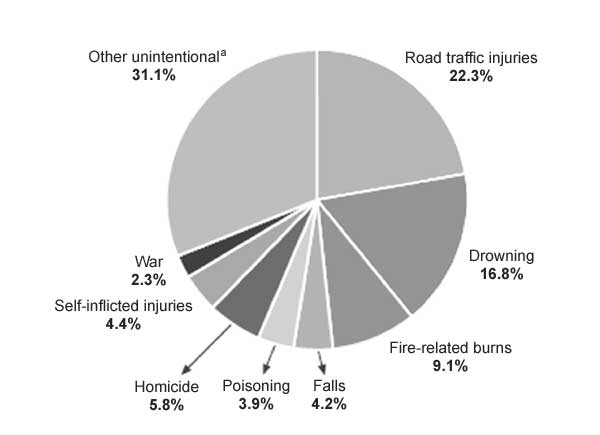Facts About Child Injuries
Injuries are the leading cause of death for children
over 9 years. Road traffic injuries and drowning account for nearly half
of all unintentional child injuries. The top five causes of injury related
deaths are (Fig. 1):
1. Road traffic injuries: They kill 260, 000
children a year and injure about 10 million. Road traffic injuries alone
are the leading cause of death among 15–19 year olds and the second
leading cause among 5–14 year olds.
2. Drowning: It kills more than 175, 000
children a year. Every year, up to 3 million children survive near
drowning incident leading to brain damage in many survivors. Non-fatal
drowning has the highest average lifetime health and economic impact of
any injury type.
3. Burns: Fire-related burns kill nearly
96,000 children a year and the death rate is 11 times higher in low- and
middle-income (LMI) countries than in high-income countries.
4. Falls: Nearly 47, 000 children fall to
their deaths every year, and hundreds of thousands more sustain less
serious injuries from a fall.
5. Poisoning: More than 45, 000 children die
each year from unintended poisoning.
 |
|
Fig.1 Distribution of global child
(0–17 years) injury deaths. Other unintentional includes
categories such as smothering, asphyxiation, choking, animal and
venomous bites, hypothermia and hyperthermia, and natural disasters. |
The report highlights the plight of children in the
developing world and shows global inequities in child injuries. Children
in poorer countries and those from poorer families in better-off countries
are the most vulnerable. More than 95% of all injury deaths in children
around the world occur in LMI countries. Children in Africa have the
highest unintentional injury rates in the world at 53 per 100, 000,
followed by Southeast Asia (49 per 100, 000), compared with an average
global rate of 39 per 100, 000 children. Countries such as Australia,
Sweden, the UK and Canada have the lowest rates of child injury, at around
five per 100, 000 children. High-income countries have reduced their child
injury deaths by up to 50% over the past three decades by implementing
multi-sectoral, multi-pronged approaches to child injury prevention(1).
Key Recommendations
The report promotes a set of seven overarching
recommendations to address child injury (Box).
Statement is Not Enough – Action is Needed
Despite the size of this burden and the known potential
for prevention, the lack of global attention to injuries in terms of both
policies and resource investments in public health is surprising. About
half of these deaths could be prevented by proven measures such as
expanding the use of car seats, covering wells and pools of water in areas
where children play, erecting barriers to keep young people away from
construction sites etc.(1).
Though child survival initiatives have been highly
successful, further improvements in child health will require broad
programs for injury reduction and control. Economic analysis needs to
define both the costs of injuries to health systems and the cost of
response. Also, health-financing schemes need to integrate injury care(2).
Every child lost to injury or severely disabled will cost the future
economy of that country. Putting into practice what is known about
reducing child injury will help meet the Millennium Development Goals. It
will reduce costs in the health care system, improve the capacity to make
further reductions in injury rates, and will protect children. It is time
for the global health community to recognise the toll of childhood
injuries and make concerted efforts to reduce that burden. Child health
without child-injury prevention and control is no longer acceptable.

